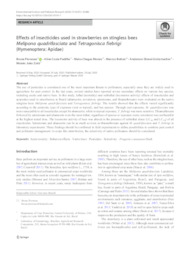Effects of insecticides used in strawberries on stingless bees Melipona quadrifasciata and Tetragonisca fiebrigi (Hymenoptera: Apidae).
Effects of insecticides used in strawberries on stingless bees Melipona quadrifasciata and Tetragonisca fiebrigi (Hymenoptera: Apidae).
Autoria: PIOVESAN, B.; PADILHA, A. C.; MORAIS, M. C.; BOTTON, M.; GRÜTZMACHER, A. D.; ZOTTI, M. J.
Resumo: The use of pesticides is considered one of the most important threats to pollinators, especially since they are widely used in agriculture for pest control. In the last years, several studies have reported severe secondary effects on various bee species, including exotic and native bees. In this study, lethal (mortality) and sublethal (locomotor activity) effects of insecticides and acaricides used in strawberries in Brazil (abamectin, novaluron, spinetoram, and thiamethoxam) were evaluated on the native stingless bees Melipona quadrifasciata and Tetragonisca fiebrigi. The results showed that the effects varied significantly according to the pesticide, type of exposure (oral or topical), and bee species. Through oral exposure, M. quadrifasciata was more susceptible to all insecticides except for abamectin, while in topical exposure, T. fiebrigi was more sensitive. Thiamethoxam followed by spinetoram and abamectin were the most lethal, regardless of species or exposure route; novaluron was not harmful at the highest tested dose. The locomotor activity of bees was altered in the presence of sublethal doses (LC10 and LC50) of all insecticides. Spinetoram and abamectin can be as much as toxic as thiamethoxam against M. quadrifasciata and T. fiebrigi in laboratory experiments. These findings should be confirmed in field experiments to define possibilities to combine pest control and pollinator management. In crops like strawberries, the selectivity of native pollinators should be considered. Keywords: Acute toxicity; Behavior effects; Fragaria x ananassa Duch; Native bees; Pesticides; Selectivity.
Ano de publicação: 2020
Tipo de publicação: Artigo de periódico
Unidade: Embrapa Uva e Vinho
Palavras-chave: Acute toxicity, Behavior effects, Fragaria x ananassa Duch, Native bees, Pesticides, Selectivity
Observações
1 - Por padrão são exibidas publicações dos últimos 20 anos. Para encontrar publicações mais antigas, configure o filtro ano de publicação, colocando o ano a partir do qual você deseja encontrar publicações. O filtro está na coluna da esquerda na busca acima.
2 - Para ler algumas publicações da Embrapa (apenas as que estão em formato ePub), é necessário ter, no celular ou computador, um desses softwares gratuitos. Sistemas Android: Google Play Livros; IOS: iBooks; Windows e Linux: software Calibre.
Acesse outras publicações
Acesse a Base de Dados da Pesquisa Agropecuária (BDPA) para consultar o acervo completo das bibliotecas da Embrapa.

